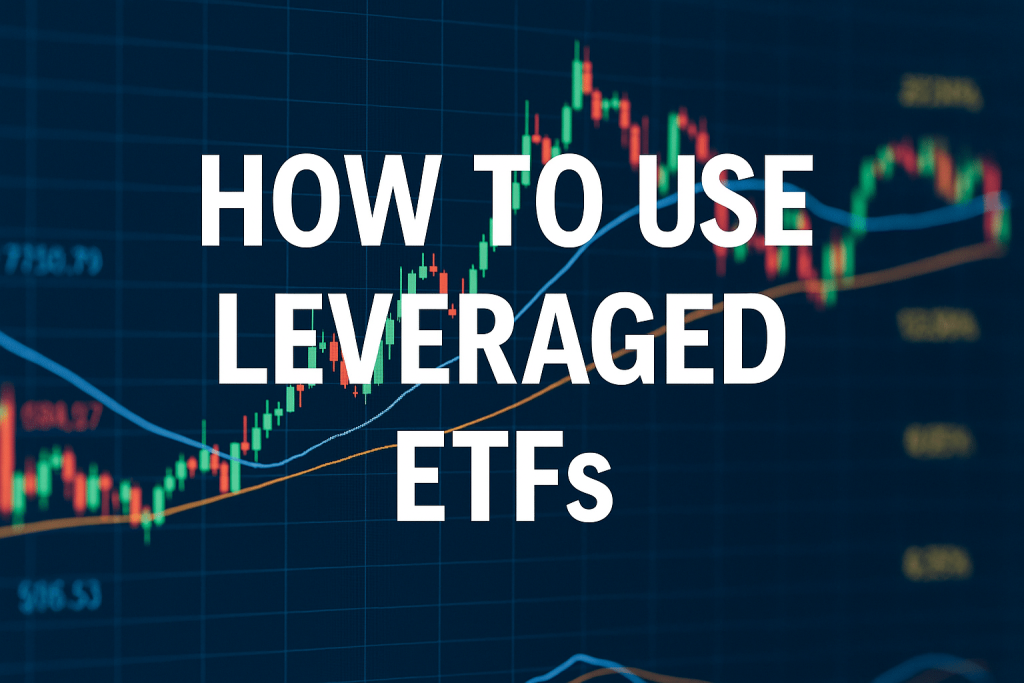How to Use Leveraged ETFs Safely and Strategically (2025 Guide)

Leveraged ETFs are powerful tools that can amplify your returns—or your losses. They aim to deliver 2x or 3x the daily return of an underlying index. If used wisely, leveraged ETFs can enhance short-term performance. If misused, they can erode capital quickly.
In this guide, you’ll learn how to use leveraged ETFs, the risks involved, and strategies to trade them effectively.
What Are Leveraged ETFs?
Leveraged ETFs use derivatives and debt to multiply the performance of a specific index or asset class.
Examples:
- TQQQ – 3x Nasdaq-100
- SPXL – 3x S&P 500
- FAS – 3x Financial Sector
- UVXY – 1.5x VIX Futures
- SQQQ – 3x Inverse Nasdaq-100
They reset daily, which is important for understanding compounding risks.
When Should You Use Leveraged ETFs?
Leveraged ETFs are best used for:
- Short-term trades (1–10 days)
- Tactical market plays
- Hedging positions temporarily
- Capturing volatility or momentum bursts
They are not recommended for long-term investing due to decay from daily rebalancing and market whipsaws.
How to Use Leveraged ETFs: 5 Key Steps
1. Understand the Underlying Index
Before you trade a leveraged ETF, study its base index. For example:
- TQQQ tracks Nasdaq-100
- SPXL tracks S&P 500
If the underlying index is trending strongly, the leveraged ETF can magnify returns.
2. Use Technical Analysis to Time Entries
Use tools like:
- Moving Averages (9 EMA, 21 EMA)
- MACD crossovers
- RSI between 50–70 in uptrends
- Volume breakout confirmation
Look for momentum signals to enter leveraged ETF trades at the right time.
3. Set Tight Stop Loss and Profit Targets
Due to 2x/3x leverage, a 2% move in the index can mean 4–6% in the ETF.
Tips:
- Use stop-losses at 3–5% below entry
- Take profit at 5–10% move depending on market strength
- Don’t hold through sideways markets
4. Avoid Holding Through High Volatility
Volatility decay is real. If the market whipsaws up and down, the ETF loses value even if the index returns to the same level.
Avoid during:
- Earnings week
- FOMC or Fed meetings
- Overnight gap risks
5. Use Inverse ETFs for Bearish Plays
You can go short using inverse leveraged ETFs like:
- SQQQ (3x short Nasdaq-100)
- SPXS (3x short S&P 500)
- FAZ (3x short financials)
Only trade these with conviction and tight stop-losses.
Common Leveraged ETF Mistakes to Avoid
- Holding for weeks or months
- Using as buy-and-hold investments
- Ignoring underlying index performance
- Trading without stop-losses
- Using full capital instead of fractional risk exposure
Final Thoughts
Leveraged ETFs are excellent for short-term tactical trading—not long-term investing. Understand the underlying index, monitor momentum, and always protect your capital. If used wisely, they can provide high-impact trades in trending markets.
FAQs
Q1. Can I use leveraged ETFs in retirement accounts?
A: Technically yes, but it’s discouraged due to risk. These are for active, short-term strategies.
Q2. Are leveraged ETFs safe?
A: They’re safe only when used correctly, with risk control and short holding periods.
Q3. What is the main risk of leveraged ETFs?
A: Volatility decay due to daily rebalancing in choppy markets.
Q4. Is TQQQ better than QQQ for trading?
A: For short-term moves, yes. But QQQ is better for long-term holding.
Q5. How long can I hold a leveraged ETF?
A: Ideally 1–10 trading days. Avoid holding over weekends or during major economic events.